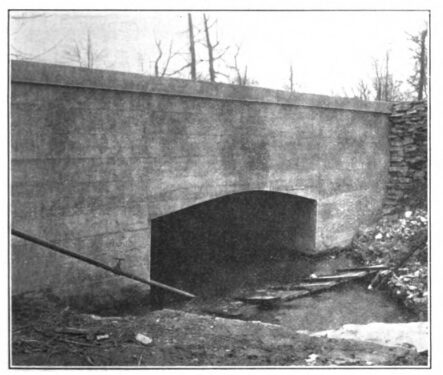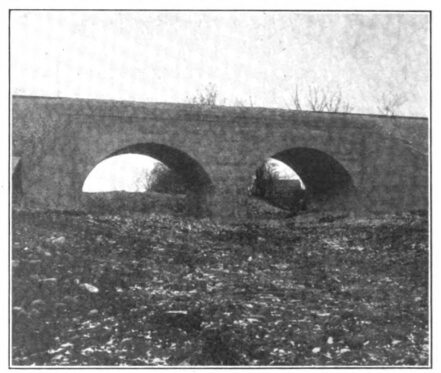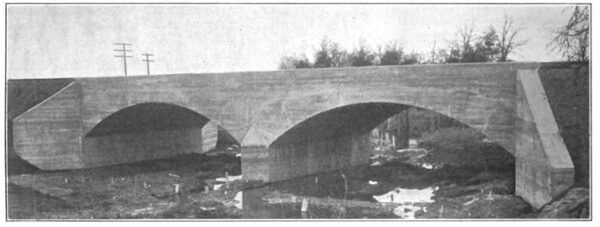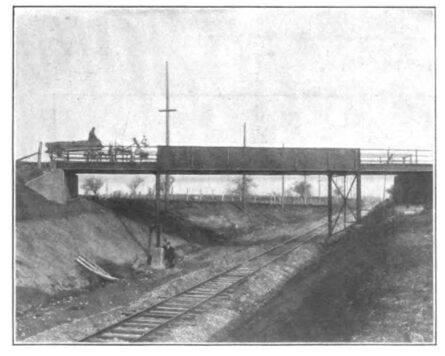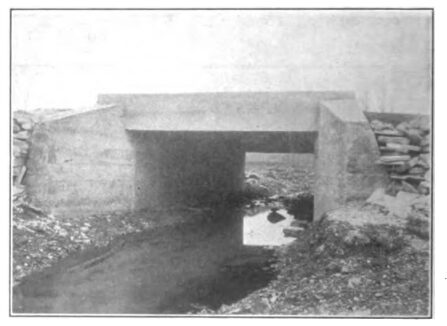[Trade Journal]
Publication: Street Railway Journal
New York, NY, United States
vol. 19, no. 5, p. 143-146, col. 1-2
Construction Work on the Aurora, Elgin & Chicago Railway
The Aurora, Elgin & Chicago Railway, when completed, will probably afford the best example of heavy high-speed electric railway work to be found in the world. This road is being constructed from the Fifty-Second Avenue terminus of the Metropolitan West Side Elevated Railway in the western edge of Chicago to Wheaton, and from there one branch runs southwest to Aurora, and the other branch northeast to Elgin. From Fifty-Second Avenue to Elmhurst the line very nearly parallels the Chicago Great Western Railroad, and through Lombard, Glen Ellyn and Wheaton parallels the Chicago & Northwestern Railway. The territory through which this line passes is an excellent one for suburban travel. Between Chicago and Wheaton the Chicago & Northwestern Railway gives the principal service at the present time. Between Wheaton, which is the county seat of Du Page County, and Aurora there is at present no direct line, though the Chicago & Northwestern Railway has an indirect line by way of Geneva. The accompanying map, showing the lines of the Aurora, Elgin & Chicago Railway under construction, and the territory through which it passes, will aid to an understanding of the situation. Between Wheaton and Elgin and Wheaton and Aurora the country is without any large villages, though it is a thickly settled and productive farming country all the way. The syndicate controlling this company has also acquired control of the electric lines connecting Aurora, Batavia, Geneva, St. Charles, Elgin and Carpentersville.
| |||
| Masonry and Steel Bridge — Aurora, Elgin & Chicago Railway |
The chief interest in the road to the electric railway engineer, however, aside from the local situation, is the solidity of the construction, and the high speed at which itis expected to operate trains in suburban service. In his statement before the New York State Railroad Commissioners at the time of the New York & Portchester [sic] Rochester Railway hearing W. B. Potter, chief engineer of the General Electric Company, made the statement that the Aurora, Elgin & Chicago schedule speed was to be 40 miles per hour, including stops, with the stations 3 miles apart, the cars weighing 40 tons, and this with a maximum speed of 65 miles per hour. This gives a general idea of the schedule which will probably be maintained when the road is completed. Of course, as a matter of fact, the location of stopping places will vary considerably from the figure given. In some places, as for example, between Wheaton and Elgin, long runs can be made at maximum speed. The motor equipment is designed and guaranteed to maintain a car at a maximum speed of 70 miles per hour on the level at normal voltage on the third rail. To insure this high speed the motor equipment will be very heavy, indeed the heaviest yet put on cars for this class of service. Each car will have four 125-hp General Electric motors. The cars and trucks will follow M. C. B. standards quite closely. The General Electric multiple-unit or train-control system is to be put on all the cars. It is the intention to run cars either singly or in trains. In case trains are made up consisting of as many as three cars, one of these cars will have no motors, otherwise every axle on the train will have a motor.
| |||
| Solid Masonry Bridge |
| |||
| 15-Ft Masonry Arch and Fill |
The track construction which is now going on is of the most thorough character and leaves little doubt as to the practicability of attaining the high maximum speed contemplated. The culverts and bridges are of a solidity which savors strongly of English steam railroad construction, as can be seen from the views of construction work accompanying this article. Wherever possible the highway has been carried over or under the road, and in doing this no makeshift construction has been employed, as the engravings testify. From Chicago to Wheaton the line is to be double tracked. From Wheaton to Elgin and Aurora single track lines are being built. However on the single track the sidings are of considerable length, to avoid loss of time at the passing points. For example, between Wheaton and Aurora there are about two miles of siding. The line is ballasted and graded throughout after the best steam road construction. In some places very deep cuts and high fills have been necessary. The track rails are 80 lbs. to the yard and 60-ft. lengths.
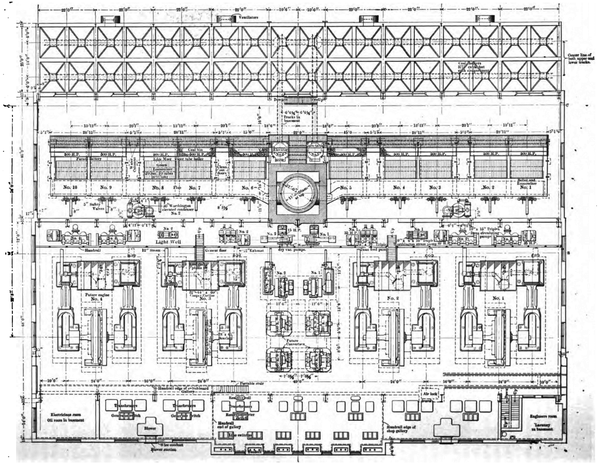 |
| Plan of Power Station — Aurora, Elgin & Chicago Railway |
The road is to use the third rail, except in the towns of Elgin and Aurora, where it does not run over a private right of way. The third rail is to be 100 lbs. to the yard located in the standard position outside of the track rails, as adopted by the elevated roads of Chicago and other cities. The conductivity afforded by this 100-lb. section of T-rail will be sufficient so that no copper direct-current feeders will be necessary. The power is to be transmitted at 26,000 volts over three-phase lines supplying sub-stations, located as shown on the map. All these sub-stations will feed direct into the third rail, which will not be normally sectioned, but will be all tied together, so that the sub-stations will assist each other. The power house is being built at Batavia on the Fox River, as indicated on the map. The plan of this power house is shown herewith. At first three of the 1500-kw units will be installed. From the power house three three-phase, 26,000-volt aluminum feed lines will be run out. The arrangement will be such as to give duplicate feed lines to most of the road. One line will run directly from the power house to sub-station 1, at Aurora. From there to sub-station 2, at Warrenville, and then to sub-stations 3 and 4 on the main line. Another line will run directly from the power house to the Warrenville sub-station, where it will join the high-tension line from Aurora. Another high-tension line running direct from the power house to sub-station 5 will also run north-west to feed sub-station 6, and will be continued east to sub-stations 3 and 4. Sub-stations 3 and 4 will, therefore, be supplied from two high-tension lines, one of which comes from the power house by way of sub-station 5 and one by way of sub-station 2. The high-tension lines, there-fore, practically form two loops, so that in case of a break anywhere on the high-tension lines current can be supplied from the other direction, except in case of sub-station 6,which for the present will have only one source of supply. The high-tension lines are to be run on poles 35 ft. to 40 ft. in the country, and 50 ft. to 60 ft. in the towns through which the road passes.
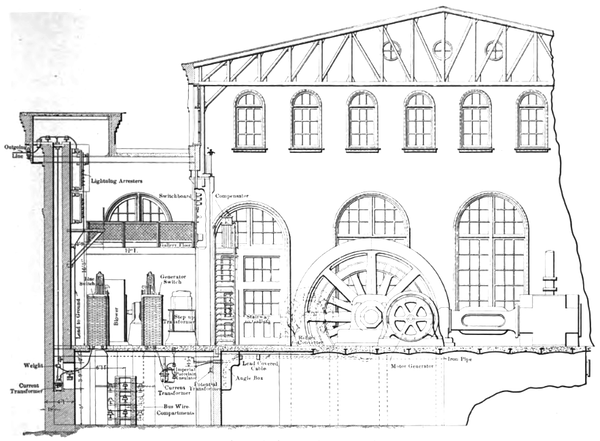 |
| Cross Section of Power Station |
The cars are being built by the Kuhlman Company, of Cleveland, and the Niles Car & Manufacturing Company, of Niles, Ohio, and will be finished in steam railroad style.
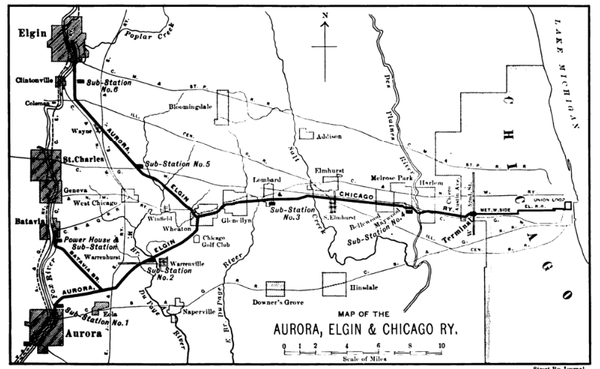 |
| Map Showing Route of Aurora, Elgin & Chicago Railway |
| |||
| 35-Ft Masonry Arches |
A telephone despatching system is to be used, and the sub-station's attendants will receive messages from the despatcher and deliver them to the train crews. This is similar to the system used on the Albany & Hudson Railway. Ernest Gonzenbach, formerly of the Albany & Hudson Railway, is electrical engineer of the Aurora, Elgin & Chicago Railway. Charles Jones is chief engineer of the road, and to him is due much of the credit for the substantial engineering which is to be seen everywhere along the line.
| |||
| Cut and Highway Viaduct |
| |||
| Masonry and Steel Culvert |
The road is being built by what is popularly known as the Mandelbaum syndicate, of Cleveland, the officers being as follows: President B. Mahler, Cleveland; vice-president, L. J. Wolf, Cleveland; second vice-president, Will Christy, Cleveland; treasurer, M. J. Mandelbaum, Cleveland; secretary, Edward Dickinson, Chicago; manager, F.B. Bicknell, Chicago.


